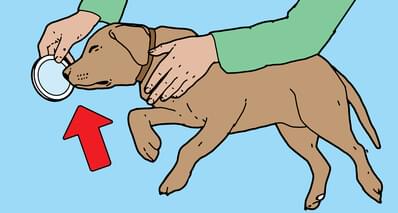From small injuries to more serious accidents, it’s a good idea to know some basic first aid for your dog. Petplan veterinary expert Brian Faulkner shares some tips for how you can keep your furry friend as comfortable as possible while you wait to see your vet.
Dogs are known for their enthusiasm but sometimes, this can get them in trouble. If your dog gets injured, it’s always important to seek professional vet treatment as soon as possible. But it’s also a good idea to know some basic dog first aid techniques that you can use immediately after an accident.
What can I do if my dog is bleeding?

Dogs can often end up with punctures to their paw pads, cuts, and torn claws. If you notice your dog is bleeding, try to see where the blood is coming from. Is it a minor scrape or a more serious deep cut? Apply firm pressure over the injury using a clean bandage. If you don’t have one to hand, a clean handkerchief or tea towel will do the same job. If you have a basic human or dog first aid kit, you can wrap some tape around the bandage to keep it secure before you see the vet. This also helps to keep the wound as clean as possible and reduce further bleeding.
What can I do if my dog has broken a bone?

Sometimes, you might notice your dog is moving with difficulty or showing signs of pain. These behaviours can indicate they’re hurt and one reason can be a broken bone. Other times, in the case of a compound fracture, you’ll see the bone has broken through the skin. In the case of a compound fracture, you might be able to apply a loose bandage to keep the area clean, but don’t try to apply a splint or give your dog any medication, like aspirin, that you may have at home.
What can I do if my dog is choking?

While it’s relatively rare for dogs to choke, they can sometimes get small items trapped in the back of their throat. In this instance, don’t put your hand in your dog’s mouth to try and pull the object out. It can be hard to get a good grip and your dog’s bite reflex may result in you getting hurt, too.
Instead, place your thumbs behind your dog’s jaw, towards their collar, and gently but firmly push upwards towards their chin. This helps you push from behind the obstruction and the pressure is often enough to dislodge the object. If this doesn’t work, take your dog to the vet as soon as possible. Don’t be tempted to try the Heimlich manoeuvre as dogs don’t really have the right body shape for this to work. There’s a danger you may break their bones and cause damage to their organs, or get bitten.
What can I do if my dog has stopped breathing?

You’ll usually be able to see your dog’s ribcage rise and fall as they breathe but if you can’t, it can be worrying. One way to check their breathing is to place a cold mirror or glass in front of your dog’s nose. You should see condensation form as they breathe out. If your dog has stopped breathing, and you can’t feel their heart beating, place them in the sternal position shown below, call your vet for an urgent appointment and rush them straight there.
What can I do if my dog has collapsed?

If your dog has collapsed, call your vet immediately. They will likely advise an urgent appointment. Performing cardiopulmonary resuscitation (CPR) at home on dogs isn’t always recommended because it can end up either breaking their bones or puncturing their organs.
Instead, place your dog in the sternal position shown above. Place them on their stomach with their front paws in front of them. This helps to straighten their airways and allows their ribcage to move freely, both of which can help air to flow in and out of their lungs more easily.
While you wait for vet support, take a look around and see if there’s anything that caused your dog to collapse. Eating poisonous food like chocolate, onions, or even peanut butter containing xylitol can make your dog very sick.
What can I do if I can’t feel my dog’s heartbeat?

A dog’s heart is positioned low and forwards in their chest. To check your dog’s pulse, place your fingers on either side of the rib cage, between the front legs. When you apply gentle pressure, you should be able to feel their heartbeat. This can be more difficult with certain deep-chested breeds, like Bulldogs, or overweight dogs. If you can’t feel a heartbeat, place your dog in the sternal position described above and take them to the vet urgently.
From minor cuts to a serious injury from a road traffic accident, it can be scary when our dogs get hurt. If you’re ever worried that your dog is injured or unwell, it’s always best to take them to the vet as soon as possible. In the meantime, though, it’s always worth knowing some basic first aid for dogs to help your dog stay as comfortable as possible while you wait for professional advice.
